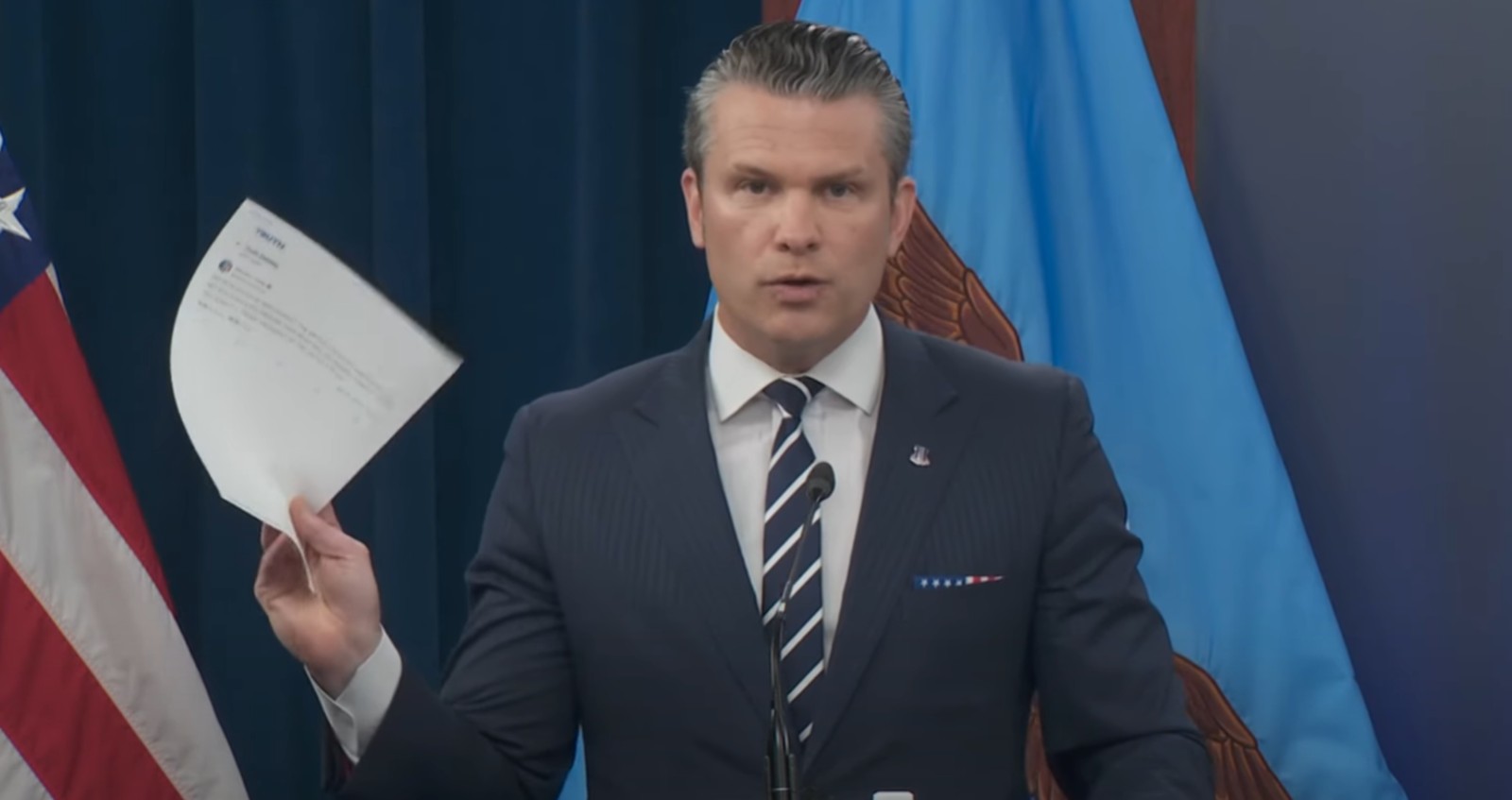Pentagon Officials Assert Strategic Success of Iran Nuclear Facility Strikes Amid Intelligence Disputes
Defense Secretary Hegseth and Joint Chiefs Chairman defend military operation while criticizing preliminary intelligence assessments and media coverage
Introduction
In a comprehensive Pentagon briefing that addressed both military operations and intelligence assessment controversies, Defense Secretary Pete Hegseth and Chairman of the Joint Chiefs of Staff Air Force General Dan Caine provided detailed justification for recent U.S. military strikes against Iranian nuclear facilities. The high-profile press conference served multiple purposes: defending the operation’s strategic value, challenging preliminary intelligence reports, and directly confronting media narratives about the mission’s effectiveness.
The briefing occurred against a backdrop of heightened regional tensions and conflicting reports about the extent of damage inflicted on Iran’s nuclear infrastructure. Senior defense officials used the opportunity to present their assessment of the operation while addressing what they characterized as premature and politically motivated criticism of the mission’s success.
Operational Background and Intelligence Indicators
Early Warning Systems and Threat Assessment
General Caine opened the briefing by outlining the intelligence foundation that prompted the military response. According to his testimony, U.S. intelligence agencies detected “indications and warnings” early Monday morning suggesting Iranian preparations for attacks against American military installations in the region. This intelligence triggered established contingency protocols designed to protect American personnel and assets.
The rapid implementation of evacuation procedures demonstrated the military’s preparedness and the effectiveness of intelligence-gathering capabilities in providing actionable warnings. Caine emphasized that the majority of personnel at risk were successfully relocated from vulnerable positions, highlighting the coordination between intelligence agencies and operational commands in implementing protective measures.
This intelligence-driven approach to personnel protection underscored the military’s commitment to minimizing American casualties while maintaining operational readiness for potential retaliatory strikes. The successful evacuation procedures validated years of contingency planning and inter-agency coordination protocols developed for exactly these types of scenarios.
Strategic Response Framework
The decision to proceed with strikes against Iranian nuclear facilities represented a calculated escalation designed to address perceived threats while targeting infrastructure critical to Iran’s nuclear weapons development capabilities. The operation reflected broader strategic objectives of degrading Iran’s nuclear program while deterring future aggressive actions against American interests.
The timing and scope of the military response demonstrated the administration’s willingness to take decisive action based on intelligence assessments while accepting the risks associated with direct military confrontation with Iranian forces. This approach reflected a shift toward more aggressive deterrence strategies in dealing with Iranian nuclear ambitions.
Intelligence Assessment Controversies
Challenging Preliminary Reports
Defense Secretary Hegseth devoted significant attention to criticizing early intelligence assessments that questioned the operation’s effectiveness. He specifically targeted a Defense Intelligence Agency (DIA) preliminary report that had been leaked to media outlets and characterized the mission’s impact as uncertain based on low-confidence intelligence.
Hegseth read directly from the preliminary DIA assessment, emphasizing its explicit acknowledgment of low confidence levels and the need for weeks of additional analysis to reach definitive conclusions. He stressed that the preliminary report was not coordinated with the broader intelligence community and relied on multiple assumptions that could invalidate its conclusions if proven incorrect.
The Defense Secretary’s critique focused on what he characterized as the premature nature of the preliminary assessment and its inappropriate use by media outlets to characterize the entire operation as unsuccessful or inconclusive. He argued that the leak of incomplete intelligence represented either poor judgment or deliberate political sabotage of the mission’s perceived success.
Alternative Intelligence Sources
To counter the preliminary DIA assessment, Hegseth cited multiple alternative sources of intelligence and analysis that provided more positive evaluations of the operation’s impact on Iranian nuclear capabilities. These sources included both domestic intelligence agencies and international organizations with independent assessment capabilities.
The Israeli Atomic Energy Commission reportedly confirmed that critical infrastructure at the Fordow nuclear facility had been destroyed, rendering the entire site inoperable for nuclear enrichment activities. This assessment carried particular weight given Israel’s sophisticated intelligence capabilities and direct stake in monitoring Iranian nuclear development.
The United Nations Atomic Energy Agency, through Director General Rafael Grossi, reportedly acknowledged “enormous damage” to Iranian nuclear sites, providing international validation of the operation’s impact. This assessment from a neutral international organization strengthened claims about the mission’s effectiveness while countering suggestions that damage assessments were politically motivated.
International and Expert Assessments
Military and Intelligence Leadership Perspectives
Senior Israeli Defense Forces leadership, including the IDF Chief of Staff, reportedly assessed that the operation had set back Iranian nuclear ambitions by years, representing a significant strategic achievement in regional security. This evaluation from military professionals with extensive experience in Middle Eastern operations provided authoritative support for claims about long-term impact.
Former CIA Director John Ratcliffe contributed to the assessment debate by claiming access to “credible intelligence” confirming the destruction of several key nuclear facilities. His statement carried weight due to his recent leadership of the intelligence community and continued access to classified information about the operation’s results.
Director of National Intelligence Tulsi Gabbard reportedly affirmed presidential statements about the effective neutralization of Iranian nuclear infrastructure, providing high-level intelligence community endorsement of the operation’s success. This support from the nation’s senior intelligence official contradicted suggestions that the intelligence community was skeptical about the mission’s achievements.
Independent Expert Analysis
David Albright, President of the Institute for Science and International Security, reportedly concluded that the joint U.S.-Israel operation had devastated Iran’s centrifuge enrichment program. As an independent expert with extensive knowledge of nuclear technology and Iranian capabilities, Albright’s assessment provided technical validation of claims about infrastructure damage.
The convergence of assessments from military leaders, intelligence officials, and independent experts created a compelling narrative about the operation’s effectiveness that contrasted sharply with preliminary reports suggesting uncertain or limited impact. This consensus among knowledgeable observers strengthened defense officials’ arguments about the mission’s strategic success.
Media Relations and Political Dynamics
Confronting Press Coverage
Perhaps the most controversial aspect of the briefing involved Hegseth’s direct criticism of media coverage surrounding the operation. He accused major news outlets, including CNN, MSNBC, and The New York Times, of providing “fawning coverage” of the preliminary DIA assessment while ignoring more positive evaluations from other sources.
The Defense Secretary characterized media coverage as politically motivated, arguing that journalists were more interested in undermining the administration than accurately reporting on military achievements. His comments reflected broader tensions between the defense establishment and news organizations over coverage of military operations and intelligence assessments.
Hegseth’s accusation that media outlets were “cheering against” the former president and hoping for operational failure represented a significant escalation in rhetoric between defense officials and the press corps. This confrontational approach reflected frustration with what officials perceived as biased or incomplete reporting about military successes.
Political Implications
The briefing’s confrontational tone toward media coverage highlighted the political dimensions of military operations and intelligence assessments in the contemporary media environment. Defense officials clearly viewed the preliminary DIA leak and subsequent coverage as attempts to undermine public confidence in the operation’s success for political purposes.
The emphasis on multiple sources contradicting the preliminary assessment suggested a coordinated effort to reshape public perception of the operation while discrediting critical coverage. This approach reflected understanding that public opinion about military effectiveness could influence political support for future operations.
Strategic and Regional Implications
Long-term Impact Assessment
According to defense officials, the operation’s impact extends beyond immediate infrastructure damage to include significant setbacks for Iran’s nuclear weapons development timeline. Intelligence assessments suggesting years of recovery time indicated that the strikes achieved strategic objectives of degrading Iranian nuclear capabilities.
The targeting of centrifuge enrichment programs, if accurately assessed, would represent a particularly significant achievement given the technical complexity and time requirements for rebuilding such capabilities. This aspect of the operation could provide years of strategic advantage in preventing Iranian nuclear weapons development.
Regional Security Considerations
The operation’s success, as characterized by defense officials, could significantly alter regional security dynamics by demonstrating American willingness and capability to degrade Iranian nuclear infrastructure through direct military action. This precedent could influence Iranian calculations about nuclear weapons development and regional aggressive actions.
The involvement of Israeli forces in the operation, as suggested by references to joint activities, indicated continued close cooperation between American and Israeli military and intelligence agencies in addressing Iranian nuclear threats. This collaboration strengthened regional deterrence capabilities while sharing operational risks and responsibilities.
Future Monitoring and Assessment
Ongoing Intelligence Collection
Defense officials indicated that intelligence collection regarding the operation’s impact would continue for weeks to provide more definitive assessments of infrastructure damage and program setbacks. This ongoing effort reflected the importance of accurate damage assessment for both strategic planning and public communication purposes.
The emphasis on continuing intelligence collection also suggested recognition that preliminary assessments, whether positive or negative, required verification through multiple sources and extended observation periods. This approach acknowledged the complexity of accurately assessing military operations against sophisticated adversaries.
Potential Iranian Responses
Pentagon officials acknowledged that Iranian retaliation remained a significant concern requiring continued vigilance and defensive preparations. The success of the nuclear facility strikes could prompt Iranian escalation through proxy forces or direct military action against American interests in the region.
The military’s readiness posture for potential retaliation included enhanced force protection measures and contingency planning for various escalation scenarios. This preparation reflected understanding that successful military operations often prompt adversary responses requiring ongoing defensive and offensive capabilities.
Conclusion
The Pentagon briefing represented a comprehensive effort to defend the Iran nuclear facility strikes while challenging critical intelligence assessments and media coverage. Defense Secretary Hegseth and General Caine presented multiple sources of evidence supporting claims about the operation’s strategic success while directly confronting narratives suggesting limited effectiveness.
The confrontational approach toward media coverage reflected broader tensions between defense officials and news organizations over the interpretation of military intelligence and operational success. This dynamic highlighted the political dimensions of contemporary military operations and the challenges of maintaining public support for complex international interventions.
The convergence of assessments from multiple intelligence sources, international organizations, and independent experts provided substantial support for official claims about the operation’s impact on Iranian nuclear capabilities. However, the ongoing nature of intelligence collection and assessment suggested that definitive conclusions about long-term strategic effects would require additional time and observation.
The briefing’s emphasis on the operation’s historical significance and strategic impact indicated that defense officials viewed the strikes as a potential turning point in U.S.-Iran relations and regional security dynamics. Whether this assessment proves accurate will depend on Iranian responses, international reactions, and the actual extent of damage to nuclear infrastructure over time.
The complex interplay of military operations, intelligence assessments, media coverage, and political considerations demonstrated in this briefing reflects the multifaceted nature of contemporary national security challenges and the difficulties of maintaining public confidence in military actions while protecting operational security and intelligence sources.

Sophia Rivers is an experienced News Content Editor with a sharp eye for detail and a passion for delivering accurate and engaging news stories. At TheArchivists, she specializes in curating, editing, and presenting news content that informs and resonates with a global audience.
Sophia holds a degree in Journalism from the University of Toronto, where she developed her skills in news reporting, media ethics, and digital journalism. Her expertise lies in identifying key stories, crafting compelling narratives, and ensuring journalistic integrity in every piece she edits.
Known for her precision and dedication to the truth, Sophia thrives in the fast-paced world of news editing. At TheArchivists, she focuses on producing high-quality news content that keeps readers informed while maintaining a balanced and insightful perspective.
With a commitment to delivering impactful journalism, Sophia is passionate about bringing clarity to complex issues and amplifying voices that matter. Her work reflects her belief in the power of news to shape conversations and inspire change.
